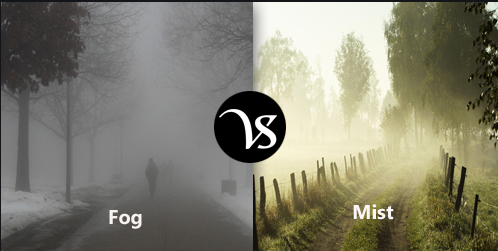What is Difference Between Fog and Mist?
Difference Between Fog and Mist is that Surely you’ve wondered what the fog is, right? It is a question that many ask ourselves, even in childhood when we wake up when we see that the neighborhood in which we live seems to have become a ‘ghost neighborhood’. Well, in this special I am not going to talk to you only about fog, but also about fog, since both concepts are often confused.
In this way, when they occur again, you will know what a difference there is between fog and fog.
What is the fog?
Fog is a hydrometeor, that is, a set of water particles, liquid or solid, falling, suspended in the atmosphere or lifted from the earth’s surface by wind, or deposited on objects on the ground or in the atmosphere free. It produces a visibility of less than 1km. These water particles are not large enough for gravity to cause them to precipitate, so they are usually suspended.
How is it produced?
Especially during the months of December and January in Spain, the fog stars almost all the sunrises of many communities. It is formed in situations of absolute stability when there is an anticyclone present and no wind blows. It occurs when the temperature of the lower layers of the atmosphere is lower than in the upper ones, or what is the same: when it is colder on the beach than in the mountains.
Types of fog
While we might think that the fog is always the same in all places, the reality is that different types are distinguished:
- Radiation: which is what we see after sunset on a cloudless night, in autumn. It has a thickness of one meter and lasts little.
- Ground: it is a fog of radiation, but very superficial. It darkens less than 60% of the sky and does not extend to the base of the clouds.
- Advection: when hot air masses loaded with moisture pass over cold soils, this type of fog occurs. It is very common on the coasts.
- Steam: appears when cold air passes over warm waters. This fog in which we can see in the polar regions.
- Rainfall: if it rains and the air under the cloud is dry, surely our visibility will be reduced.
- Of slope: it is formed when the wind blows against the slope of a mountain.
- Valley: This type of fog is the result of thermal inversion, caused by a cold air that remains in the valley, while other warmer air passes over it.
- Ice occurs when frozen water droplets are suspended on the ground. It is very common in polar regions.
- Upward slope: occurs when the pressure drops with altitude.
Is it dangerous to health?
Not at all. It is often thought that yes, it can cause us some damage, but the truth is that what is fog is not harmful. The air you are going to breathe the only difference it has with which we breathe any other day is that it concentrates a greater amount of water vapor.
But what you should keep in mind is that these days there will be much more pollution by not blowing the wind, so if you are allergic you may notice that your symptoms get a little worse. And, by the way, if you are going to take the car, don’t be very careful on the road.
What is the fog?
Now that we have seen what the fog is, let’s see what the fog is. Well, the mist is also a hydrometeor, which is made up of very small drops of water, between 50 and 200 micrometers in diameter. They reduce horizontal visibility at a distance of one kilometer or more.
It occurs naturally by atmospheric processes or the result of volcanic activity and occurs frequently when there is a mass of cold air in the atmosphere under a temperate one. In the mist the air generally does not give the sensation of sticky and humid, in addition, the relative humidity is well below 100 percent. Another feature is that it forms a slightly dense grayish/bluish veil that covers the landscape. What is the Difference Between Fog and Mist
And how is the fog different from the fog?
Basically they differ by observing them. I explain myself: the fog does not allow to see beyond 1km, while the fog does. In addition, the air when there is a fog bank is sticky and humid, since the relative humidity approaches 100%.
We will also know if it is foggy when we cannot observe the sun’s rays. The fog, being less dense, will allow us to see them without too much trouble; instead with the fog that will be impossible.
I hope I have clarified your doubts about these two meteorological phenomena that astonish children and adults. What is the Difference Between Fog and Mist
You May Also Interested:
